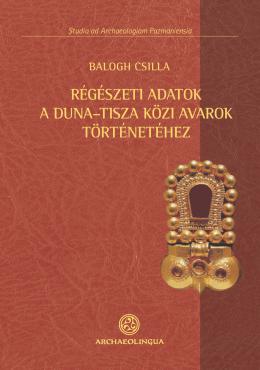Régészeti adatok a Duna-Tisza közi avarok történetéhez

Régészeti adatok a Duna-Tisza közi avarok történetéhez
| 26 933 Ft |
| Price |
ONLY A FEW COPIES LEFT! // MÁR CSAK NÉHÁNY PÉLDÁNY ELÉRHETŐ!
Archaeological Studies of Pázmány Péter Catholic University Department of Archaeology
Budapest, Archaeolingua, 2016
Keménykötés | Hardback
492 oldal, színes és fekete-fehér illusztrációkkal | 492 pages with colored and grayscale images
ISSN 2064 8162
ISBN 978 963 9911 85 7
Table of contents // Tartalomjegyzék
Description
This book is a partly revised and updated version of my doctoral thesis, A Duna-Tisza köze avar kori betelepülésének problémái [The settlement of the Avars in the Danube–Tisza interfluve], defended in 2014. The main goal of the thesis was to address the issue of the occupation and settlement of the Danube–Tisza interfluve through the collection, classification and assessment of the region’s Avar-period finds, most of which were unpublished. The issues discussed in the thesis were not restricted to the region’s occupation, namely to the question of who had arrived to the region first and why, and how they took possession of the region; I also examined whether there is any evidence for the subsequent arrival and settlement of other groups and for internal migrations, and I also examined the responses of the communities living in the region to the various processes in the Avar Khaganate, how they reacted to environmental changes, the communication of the communities living in the region with other areas within and beyond the Avar Khaganate, and their “official” and interpersonal contacts.
The text of the thesis was slightly revised later, and a few new chapters were added which addressed in greater detail certain issues that had received less attention in the thesis. This book therefore offers a more comprehensive picture of the Avar-period archaeological relics of the Danube-Tisza interfluve known to date. Despite the roughly seventy thousand graves known from some two and half thousand sites in the Carpathian Basin, we still lack regional overviews of burial customs and find assemblages based on a systematic collection and comprehensive assessment of the relevant material, even though many questions can only be answered in general terms and, very often, but vaguely in the lack of such systemising works. This study seeks to offer a comprehensive overview of the Avar period in the Danube-Tisza interfluve, which can serve as a basis for further research in this region and as a comparative material for other regions in the Carpathian Basin.
| |
|
|
1067 Budapest, Teréz krt. 13. |
|
|
|
|
About us
The Archaeolingua Foundation and Publisher is involved in publishing series and standalone publications in the disciplines of archaeology, linguistics, historic sciences and heritage protection for over 25 years.
Learn more
Publishing
We publish both as standalone editions and as a volume of a professional series.
Learn more
Contact us
Archaeolingua Foundation

